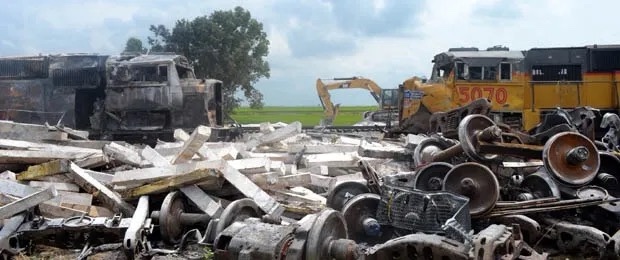In the early morning hours of August 17th, 2014 two Union Pacific Freight Trains collided head-on south of Hoxie.
ORIGINAL ARTICLE:
South Hoxie Evacuated Due to Late Night Train Collision
AUG 17, 2014
At 2:36 am page alerts went out to the Hoxie Fire Department and Walnut Ridge Hazmat for what was thought to be a train derailment on the tracks on hwy 67 towards Minturn.
Once responders were on scene they found what appeared to be a head on collision between two trains. There are reports of a least two dead, several injured, a chemical spill, and one of the trains on fire.
At 3:30 am Lawrence County Sheriffs Office, Walnut Ridge Police Department and Hoxie Police Department began evacuating the south end of Hoxie. Walnut Ridge and Hoxie PD are going door to door evacuating people at this time. The Walnut Ridge Community Center has been opened up to take in the evacuees from Hoxie.
Lawrence County OES and ADEM were both notified of the disaster. Walnut Ridge Fire Department has called for assistance from Greene County and Randolph County Hazmat Teams.
Craighead County and the Arkansas State Police have brought in units to help block traffic on Hwy. 63 into Hoxie.
Representatives from Union Pacific are on their way to assess the situation.











REPORT FROM NTSB:
Railroad Accident Report: Collision of Two Union Pacific Railroad Freight Trains
What Happened
On August 17, 2014, at 2:28 a.m. central daylight time, southbound Union Pacific Railroad (UP) freight train IMASNL-16 (southbound train) collided with northbound UP freight train IQNLPI-17 (northbound train) at milepost (MP) 228.6, while traversing the turnout at control point (CP) Y-229 on the UP Hoxie subdivision in Hoxie, Arkansas.1 Going north, the track in the area transitions from a single main track into two main tracks. As a result of the collision, the engineer and the conductor from the southbound train died, and the engineer and the conductor from the northbound train were seriously injured.
The following safety issues are covered in the report:
Fatigue and Employee Work Schedules: Regulatory requirements to use science-based tools, such as biomathematical models, are needed to reduce start time variability that results in irregular work-rest cycles and train crew fatigue
Medical Issues: Regulatory requirements for screening, evaluating, and ensuring adequate treatment standards for sleep apnea and other sleep disorders for railroad employees in safety-sensitive positions
Union Pacific Railroad Medical Rules: Union Pacific Railroad needs: (1) medical rules that would require railroad employees in safety-sensitive positions to report all diagnosed sleep disorders; and (2) to perform periodic evaluations to ensure the condition is appropriately treated
Automated Systems that Reset Alertness Devices: An automatic horn sequencer prevented the operation of an electronic alertness device that was designed to help the southbound train crewmembers maintain vigilance in the locomotive cab by monitoring engineer activity and applying the train brakes should the device fail to detect activity for a predetermined period of time
Positive Train Control: A functioning positive train control system would have prevented this accident .
What We Found
We determined that the probable cause of the accident was the failure of the southbound train crewmembers to respond to the signal indications requiring them to slow and stop their train prior to control point Y-229 because they were fatigued and had fallen asleep due to (1) the locomotive engineer’s inadequately treated obstructive sleep apnea, (2) the conductor’s irregular work schedule, and (3) the train crew operating in the early morning hours when they were predisposed to sleep. Contributing to the accident was (1) the lack of a functioning positive train control system; (2) the use of an automatic horn sequencer that, when activated, negated the operation of an electronic alertness device; (3) the Federal Railroad Administration’s failure to promulgate rules regarding sleep disorders; and (4) the absence of federal regulations requiring freight railroads to use fatigue modeling tools for train crew work schedules.
What We Recommended
As a result of the investigation of this accident, we made new safety recommendations to the Federal Railroad Administration; BNSF Railway, Canadian National Railway, Canadian Pacific Railway, CSX Transportation, Kansas City Southern Railway, Intercity Railroads, and Commuter Railroads; Class I Railroads; and Union Pacific Railroad. Further, the National Transportation Safety Board reiterates two recommendations to the Federal Railroad Administration.
